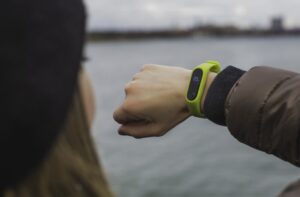
Everybody’s raving about all these high end fitness trackers, right? But honestly, do you need to spend a fortune to keep tabs on your daily steps or heart rate? Nah! Affordable fitness trackers offer a sweet deal for anyone looking to stay active without breaking the bank.
Budget friendly trackers can nail those basic needs like step counting, heart rate monitoring, and even sleep tracking. The real win here is accessibility they strip away the excess, leaving you with a device that focuses on what truly counts without all the fluff. Plus, they’re perfect for the everyday person who wants a bit more activity in their life without forking out the big bucks.
Who’s this really for? Well, if you’re a beginner starting your fitness journey or just someone with no interest in splurging on tech, these budget trackers are your jam. They can be a game-changer for anyone looking to up their fitness game a notch whilst keeping the cost in check.
Key Considerations When Choosing a Fitness Tracker
When picking out your new fitness sidekick, a few key features can make or break the deal. Let’s talk battery life first. You definitely don’t want to be tied to a charger every other day, so look for something that promises at least 5 to 7 days of juice. This way, you can keep tracking your steps without interruptions.
Compatibility is another biggie. Make sure the tracker plays nice with your phone, whether it’s Android or iOS. You wouldn’t want to snag a tracker, only to find it won’t sync with your smartphone.
For those who love to make a splash, don’t skip on water resistance. Even if you’re not planning on swimming laps daily, knowing your tracker can handle a little water gives peace of mind—aim for 5 ATM (it’s a fancy term for good water resistance).
Accuracy’s the next star of the show. While you might expect some differences compared to the fancy models, you can still find budget options with solid heart rate and activity monitoring. Finding that sweet spot of reliability without overspending is the goal here!
Top Budget Fitness Trackers Available in the UK
Looking for the best budget-friendly fitness trackers without compromising quality? The UK market’s got you covered with some top picks that blend value and performance perfectly.
First up, the Xiaomi Mi Band 7 is a crowd favourite. Why, you ask? It packs a punch with features like a vibrant AMOLED display and heart rate monitoring, all wrapped up in a price tag hovering around £40. It’s not just about the looks—this one means business with up to 14 days of battery life.
Then there’s the Amazfit Band 5. At around £30, it’s a steal with SpO2 measurement and even Alexa built-in for those who love smart assistants. Talk about bang for your buck!
Fancy the Fitbit experience? Inspire 2 might be your match. Known for its strong community and reliable tracking, it offers Active Zone Minutes and multiple exercise modes, all under £80. You get that trusted Fitbit vibe without shelling out big bucks.
The Huawei Band 6, came swinging with its large AMOLED display and a whopping 96 workout modes. It’s got a style and function that doesn’t feel budget at all, priced at about £45.
Last but not least, there’s the Garmin Vivosmart 4, sitting at £80. This slim tracker focuses on detailed health insights like stress tracking and body battery energy, perfect for those wanting a deeper dive into their wellness without spending a fortune.
How to Maximize the Value of Your Fitness Tracker
Got your hands on a brand-new fitness tracker? Awesome! Now, let’s make the most of it without scratching your head over tech manuals. Start by setting clear fitness goals. Whether it’s boosting your daily steps or keeping your heart rate in check during workouts, your tracker is there to help you stay on top.
Using app integration is a game-changer. Most trackers pair up with apps that give you detailed insights and track your progress over time. Keeping tabs on these metrics not only motivates but guides you on when to switch things up or when you’re right on target.
Another tip is keeping that battery life extended. Simple tricks like turning off unnecessary notifications and using power-saving modes can work wonders. It means less time charging and more time hitting those fitness goals.
Remember, your tracker is designed to be your fitness buddy, not a taskmaster. Explore different features and see how they fit into your lifestyle, but don’t stress about using every single one. The goal is to make health tracking easy and beneficial for you.
Making an Informed Purchase: Tips for UK Consumers
Ready to snag a budget-friendly fitness tracker in the UK? You’ve got some great retail options to consider. Check out major spots like Amazon UK, Argos, Curry’s, and John Lewis. These retailers often have discounts or bundles that can save you money, so keep an eye out for deals.
Before you click that ‘Buy’ button, double-check compatibility with your smartphone. Most trackers are versatile, but it’s always wise to ensure they’ll sync seamlessly with your device whether it’s Android or iOS.
Another key aspect to look for is the return policy and warranty. UK customers usually benefit from flexible return options and solid warranties, especially important for budget models. A good warranty means you’re covered if something goes wrong, providing added peace of mind.
Making a smart choice doesn’t just mean grabbing the cheapest option. It’s about considering which features align best with your fitness goals while getting great value for your money. With the right approach, your fitness tracker will be a helpful companion, keeping you motivated and active without stretching your budget.
Thanks for checking this post out feel free to to leave a comment, ask questions and be sure to look on the other posts for everything fitness.



This is an insightful article on budget-friendly fitness trackers! I have a few questions to dig deeper into the topic:
You mentioned that budget trackers strip away unnecessary features—what are some common “fluff” features found in high-end models that beginners or casual users might not need?
Regarding battery life, are there any specific brands or models known for consistently delivering on their promises in this price range?
With the focus on compatibility, are there any budget trackers that stand out for seamlessly syncing with both Android and iOS devices?
You highlighted some great models for the UK market—are there any emerging trends in the budget fitness tracker space that might shape future recommendations?
Looking forward to your thoughts! This article definitely makes the case for going budget without sacrificing functionality.
Thank you for your thoughtful questions! I’m glad you found the article helpful. Let’s dive deeper into each of your queries:
1. Common “Fluff” Features in High-End Models
High-end fitness trackers often come packed with features that might be overkill for beginners or casual users. Some of the “fluff” features you can typically find in premium models, which may not be necessary for everyone, include:
Advanced Sleep Tracking: While many budget trackers offer basic sleep tracking (i.e., how long you sleep), high-end models provide in-depth analysis, such as sleep stages (light, deep, REM) and sleep score, which may not be essential for someone just starting their fitness journey.Blood Oxygen and ECG Monitoring: Features like SpO2 (blood oxygen) tracking and ECG (electrocardiogram) monitoring are useful for more health-conscious individuals, especially those with medical conditions, but they aren’t necessary for the average user.Built-in GPS: While this is a great feature for serious runners or athletes, most beginners or casual users can rely on their phone’s GPS for accurate location tracking during activities.NFC Payments (Contactless Payments): Some high-end trackers offer the ability to make payments directly from the device, which may be convenient, but not a deal-breaker for most casual users.Advanced Fitness Metrics (VO2 Max, Stress Tracking, etc.): Metrics like VO2 max, lactate threshold, or stress tracking are great for serious athletes but might be excessive for those just looking to stay active and track general health.
2. Battery Life in Budget Fitness Trackers
In the budget range, battery life can vary significantly. However, several brands and models consistently deliver excellent battery life within this price bracket. Some worth noting include:
Xiaomi Mi Band Series: Known for offering impressive battery life (up to 20 days on a single charge), even in their budget models. The Mi Band 7, for example, offers great performance for a low cost.Huawei Band Series: Huawei’s fitness bands, like the Band 6, are popular for their long-lasting batteries, often offering up to 2 weeks of use.Amazfit Bip U Series: The Amazfit Bip U Pro is another budget-friendly model with up to 9 days of battery life, making it a reliable option for casual users.Garmin Vivosmart 4: While slightly more expensive, Garmin is known for delivering on battery life—this model offers up to 7 days, which is excellent for a budget tracker.
For budget models, aim for devices that offer at least 5-7 days of battery life for a more hassle-free experience, especially if you’re using it daily.
3. Seamless Syncing with Android and iOS Devices
Compatibility across both major operating systems (Android and iOS) is a crucial factor, and many budget fitness trackers now offer this feature without issue. Some standout models that sync seamlessly with both platforms include:
Xiaomi Mi Band 7: Syncs perfectly with both Android and iOS devices, with a user-friendly app (Mi Fit or Zepp) for tracking your data.Amazfit Bip U Pro: Amazfit’s ecosystem is compatible with both Android and iOS, and the Zepp app provides a smooth syncing experience.Fitbit Inspire 2: Fitbit has been a leader in the fitness tracker market for years and offers excellent cross-platform compatibility with Android and iOS through the Fitbit app.Huawei Band 6: This model works seamlessly with both Android and iOS devices, offering syncing via the Huawei Health app.
4. Emerging Trends in the Budget Fitness Tracker Space
The budget fitness tracker space has been evolving rapidly, and there are a few key trends emerging that could shape future recommendations:
Health Monitoring Features: While budget trackers once focused primarily on activity and step tracking, we’re seeing more entry-level devices incorporating advanced health features, such as SpO2 monitoring, heart rate tracking, and stress management—features that were once exclusive to high-end models.Better Integration with Health Apps: There’s a growing emphasis on how trackers sync with popular third-party apps (e.g., Google Fit, Apple Health, Strava), providing a more holistic view of your health data.Longer Battery Life: As users demand more convenience, we’re seeing improvements in battery life across the board, even in budget models. Some trackers are pushing the limits of 2+ weeks of battery life, which was previously more common in mid-range or premium models.Smarter Features: Voice assistants (like Alexa or Google Assistant) are starting to appear on more budget models, alongside features like notifications and even basic music controls.Eco-Friendly Materials: With sustainability becoming more important to consumers, some companies are beginning to offer fitness trackers made with eco-friendly materials or more sustainable production practices.